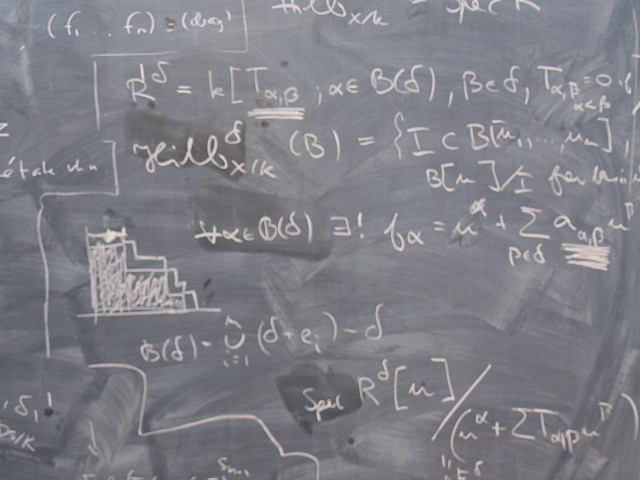SF1602 Calculus II, part 1 9.0 credits
This course has been discontinued.
Last planned examination: Spring 2019
Decision to discontinue this course:
No information inserted
Content and learning outcomes
Course contents
The concept of a function, elementary functions. Real numbers, limits, continuity. Derivatives, extremal problems. Oscillatory differential equations. Integrals, including geometric applications. Taylor's formula. Series, criteria of convergence.
Intended learning outcomes
After passing the course, the student is expected to command the following:
- The concept of function, including its set of definition and its range (value set), the notions of composition and inverse functions.
- The elementary functions (including where they are defined): polynomials, rational functions, power functions, exponential and logarithmic functions, trigonometric functions and their inverses, arcus functions. The student should also be able to differentiate these functions, and understand the underlying theory.
- The limit laws. The student should understand the derivation of the standard limits, and be able to apply these standard limits to calculate various other limits, either directly or through Taylor's formula or l'Hospital's rule.
- The derivation of the general differentiation rules, and the application of these rules to various (mostly elementary) functions. The students should
also understand how to interpret the derivative and the second derivative. - The Mean Value Theorem of calculus, including the consequences for determining where a function increases or decreases. The student should also be able to apply this theorem in concrete situations.
- The material on continuity and differentiability and be able to determine whether a given (rather simple) function is continuous or differentiable.
- The Intermediate Value Theorem and the theorem on the existence of maximum and minimum values of continuous functions on closed and bounded intervals.
- The characterization of local and global extrema in terms of the derivative(s). The student is also expected to perform curve drawing/investigation, and to be able to derive inequalities using derivatives.
- The process of calculating the indefinite integral (anti-derivative) of a given elementary function (whenever possible), using the standard general methods, such as substitution and integration by parts.
- The interpretation of definite integrals as limits of Riemann sums. The student should be able to formulate the Fundamental Theorem of Integral Calculus and show how to apply it to the calculation of definite integrals by finding the anti-derivative.
- The concepts of convergence and divergence of generalized definite integrals and how to apply these concepts in a given simple concrete situation.
- How to express curve length, areas, and volumes, in terms of integral formulas. The student is expected to be able to apply these formulas in a given concrete simple situation.
- How to solve linear differential equations of second order with constant coefficients, including initial value problems (and related problems). The student is expected to be able to determine command the decomposition into homogeneous solution plus particular solution, and to be able to find the particular solution in some simple cases.
- Taylor's formula and the Taylor polynomial and the remainder in simple cases. The student is expected to know certain standard Taylor series expansions,
including the interval of convergence, for: the geometric series, the exponential function, the basic trigonometric functions (sine and cosine).
To obtain a higher grade, the student must also command the following:
- The solution of, generally speaking, more demanding and more complex problems, and show a greater understanding of the theory and concepts, particularly as regards the theory of continuous functions.
- The definition of a limit and the concept of continuity, and the least upper bound (LUB) axiom. The student is expected to be able to show that a given function is continuous, and to be able to apply the LUB axiom to show that certain limits exist.
- Sketchy proofs of the main theorems of Calculus. The student is expected to be able to apply these theorems in problems involving, e.g., the characterization of the zero set and the range (value set) of a given function or its derivatives.
- The solution of linear differential equations of higher order with constant coefficients.
- The manipulation of integrals and series. The student is expected to be able to estimate integrals and series to decide convergence issues.
- Power series, including the set of convergence. The student should be able to obtain the general convergence properties of power series from the general theory of convergent/divergent series.
Literature and preparations
Specific prerequisites
Advanced mathematics (NT) from high school level.
Mandatory for first year. Not available to other students.
Recommended prerequisites
Equipment
Literature
Persson&Böiers/Analys i en variabel.
LTH/Övningar i analys i en variabel.
Examination and completion
If the course is discontinued, students may request to be examined during the following two academic years.
Grading scale
Examination
- TEN1 - Examination, 9.0 credits, grading scale: A, B, C, D, E, FX, F
Based on recommendation from KTH’s coordinator for disabilities, the examiner will decide how to adapt an examination for students with documented disability.
The examiner may apply another examination format when re-examining individual students.
Other requirements for final grade
One written exam (TEN1; 9 hp).
Opportunity to complete the requirements via supplementary examination
Opportunity to raise an approved grade via renewed examination
Examiner
Ethical approach
- All members of a group are responsible for the group's work.
- In any assessment, every student shall honestly disclose any help received and sources used.
- In an oral assessment, every student shall be able to present and answer questions about the entire assignment and solution.